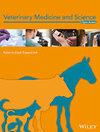RNA‐Seq analysis reveals the different mechanisms triggered by bovine and equine after infection with FMDV
IF 1.8
3区 农林科学
Q2 VETERINARY SCIENCES
引用次数: 0
Abstract
BackgroundFoot‐and‐mouth disease virus (FMDV) is an important pathogen of the MicroRNA virus family. Infection of livestock can cause physical weakness, weight loss, reduced milk production, and a significant reduction in productivity for an extended period. It also causes a high mortality rate in young animals, seriously affecting livestock production. The host range of FMDV is mainly limited to cloven‐hoofed animals such as cattle and sheep, while odd‐toed ungulates such as horses and donkeys have natural resistance to FMDV. The mechanism underlying this resistance in odd‐toed ungulates remains unclear.ObjectiveThis study aimed to analyze the differences between FMDV‐infected cattle and horses to provide valuable insights into the host‐FMDV interaction mechanisms, thereby contributing to the control of foot‐and‐mouth disease and promoting the development of the livestock industry.MethodsWe observed the distribution of integrins, which help FMDV enter host cells, in the nasopharyngeal tissues of cattle and horses using immunohistochemistry. Then, we employed high‐throughput RNA sequencing (RNA‐Seq) to study the changes in host gene expression in the nasopharyngeal epithelial tissues of cattle and horses after FMDV infection. We performed enrichment analysis of GO and KEGG pathways after FMDV infection and validated related genes through qPCR.ResultsThe immunohistochemical results showed that both cattle and horses had four integrin receptors that could assist FMDV entry into host cells. The transcriptome analysis revealed that after FMDV infection, pro‐apoptotic genes such as caspase‐3 (CASP3) and cytochrome C (CYCS) were upregulated in cattle, while apoptosis‐inhibiting genes such as NAIP and BCL2A1 were downregulated. In contrast, the expression trend of related genes in horses was opposite to that in cattle. Additionally, autophagy‐related genes such as beclin 1, ATG101, ATG4B, ATG4A, ATG13, and BCL2A1 were downregulated in cattle after FMDV infection, indicating that cattle did not clear the virus through autophagy. However, key autophagy genes including ATG1, ATG3, ATG9, ATG12, and ATG16L1 were significantly upregulated in horses after viral infection.ConclusionBoth water buffaloes and Mongolian horses express integrin receptors that allow FMDV entry into cells. Therefore, the resistance of Mongolian horses to FMDV may result from more changes in intracellular mechanisms, including processes such as autophagy and apoptosis. Significant differences were observed between water buffaloes and Mongolian horses in these processes, suggesting that these processes influence FMDV replication and synthesis.RNA-Seq分析揭示了牛和马感染口蹄疫病毒后引发的不同机制
背景口蹄疫病毒(FMDV)是微小核糖核酸病毒科的一种重要病原体。牲畜感染后会导致身体虚弱、体重减轻、产奶量下降,并在较长时间内显著降低生产力。它还会导致幼畜高死亡率,严重影响畜牧业生产。口蹄疫病毒的宿主范围主要限于牛、羊等蹄类动物,而马、驴等奇蹄类动物对口蹄疫病毒具有天然抵抗力。本研究旨在分析感染 FMDV 的牛和马之间的差异,为了解宿主与 FMDV 的相互作用机制提供有价值的信息,从而为控制口蹄疫和促进畜牧业发展做出贡献。然后,我们采用高通量 RNA 测序(RNA-Seq)技术研究了牛和马感染 FMDV 后鼻咽上皮组织中宿主基因表达的变化。结果免疫组化结果显示,牛和马都有四种整合素受体可帮助 FMDV 进入宿主细胞。转录组分析表明,牛感染 FMDV 后,促凋亡基因如 caspase-3 (CASP3) 和细胞色素 C (CYCS) 表达上调,而抑制凋亡基因如 NAIP 和 BCL2A1 表达下调。相比之下,马体内相关基因的表达趋势与牛相反。此外,牛感染FMDV后,自噬相关基因(如beclin 1、ATG101、ATG4B、ATG4A、ATG13和BCL2A1)表达下调,表明牛没有通过自噬清除病毒。结论水牛和蒙古马都表达整合素受体,可使 FMDV 进入细胞。因此,蒙古马对 FMDV 的抵抗力可能来自细胞内机制的更多变化,包括自噬和细胞凋亡等过程。水牛和蒙古马在这些过程中存在显著差异,表明这些过程会影响 FMDV 的复制和合成。
本文章由计算机程序翻译,如有差异,请以英文原文为准。
求助全文
约1分钟内获得全文
求助全文
来源期刊

Veterinary Medicine and Science
Veterinary-General Veterinary
CiteScore
3.00
自引率
0.00%
发文量
296
期刊介绍:
Veterinary Medicine and Science is the peer-reviewed journal for rapid dissemination of research in all areas of veterinary medicine and science. The journal aims to serve the research community by providing a vehicle for authors wishing to publish interesting and high quality work in both fundamental and clinical veterinary medicine and science.
Veterinary Medicine and Science publishes original research articles, systematic reviews, meta-analyses, and research methods papers, along with invited editorials and commentaries. Original research papers must report well-conducted research with conclusions supported by the data presented in the paper.
We aim to be a truly global forum for high-quality research in veterinary medicine and science, and believe that the best research should be published and made widely accessible as quickly as possible. Veterinary Medicine and Science publishes papers submitted directly to the journal and those referred from a select group of prestigious journals published by Wiley-Blackwell.
Veterinary Medicine and Science is a Wiley Open Access journal, one of a new series of peer-reviewed titles publishing quality research with speed and efficiency. For further information visit the Wiley Open Access website.
 求助内容:
求助内容: 应助结果提醒方式:
应助结果提醒方式:


